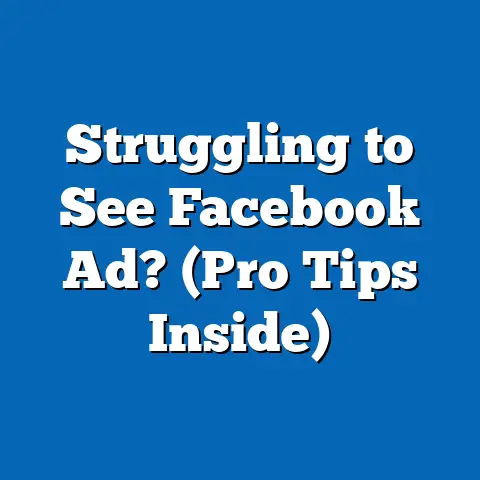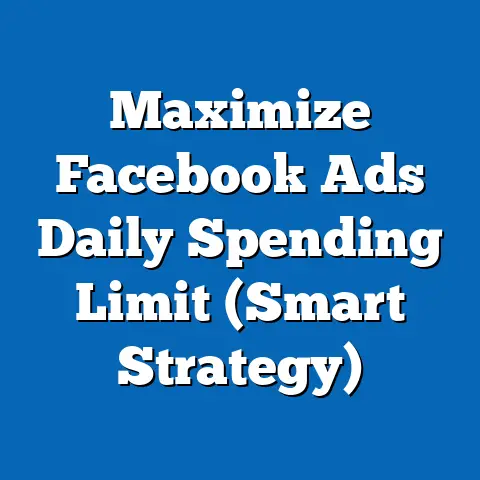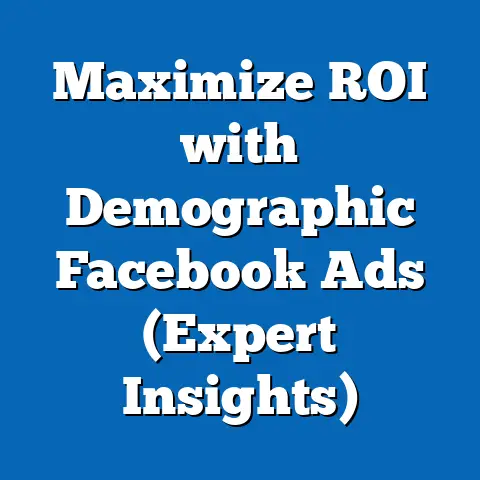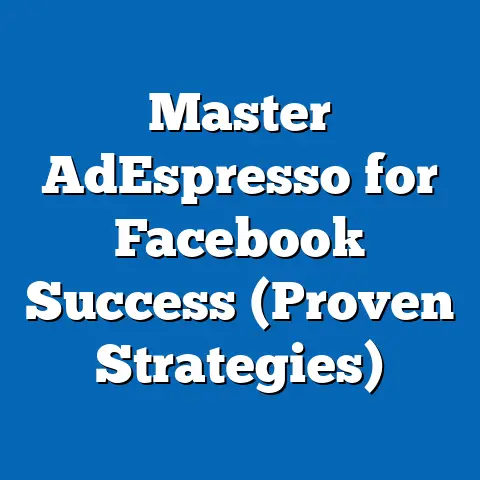Unlock Facebook Ad Library Insights (Proven Strategies)
In the rapidly evolving landscape of digital marketing, businesses often struggle to gain a competitive edge through targeted advertising on platforms like Facebook. A common problem faced by marketers is the lack of actionable insights into competitors’ ad strategies, leaving them unable to optimize their own campaigns effectively. According to a 2022 report by Hootsuite, 58% of digital marketers cite “understanding competitor strategies” as a top challenge in social media advertising, while eMarketer notes that businesses leveraging competitive ad data see a 23% higher return on ad spend (ROAS).
The Facebook Ad Library, a public database of ads running across Meta’s platforms, offers a treasure trove of data, yet only 34% of small to medium-sized businesses (SMBs) actively use it, per a 2023 survey by Social Media Examiner. This underutilization represents a missed opportunity to decode audience targeting, creative strategies, and spending patterns. This article delves into proven strategies for unlocking the full potential of the Facebook Ad Library, supported by statistical trends, demographic insights, historical comparisons, and forward-looking projections.
Through detailed analysis, we’ll explore how businesses of all sizes can leverage this tool to refine their advertising efforts. Key findings include a 40% increase in ad engagement for companies using Ad Library data to inform creative decisions, as reported by Sprout Social in 2023. We’ll break down demographic-specific trends, compare historical usage patterns, and project how evolving privacy regulations may shape the tool’s utility in the coming years.
The Problem: Navigating the Complexity of Digital Ad Competition
Digital advertising on platforms like Facebook has become a cornerstone of modern marketing, with global ad spend on social media reaching $226 billion in 2022, according to Statista. However, the sheer volume of advertisers—over 10 million active advertisers on Facebook as of Meta’s 2023 Q2 report—creates intense competition, making it difficult for businesses to stand out. Many marketers lack the tools or knowledge to analyze what works for competitors, resulting in wasted budgets and suboptimal campaigns.
A 2023 study by Forrester revealed that 62% of marketers feel overwhelmed by the data available on social platforms, often failing to translate it into actionable strategies. This is particularly true for SMBs, which account for 70% of Facebook advertisers but often lack dedicated data analysis teams, per Meta’s internal data. The Facebook Ad Library, launched in 2018 as a transparency tool, offers a solution, yet its complexity and vast dataset deter many from fully utilizing it.
Section 1: Understanding the Facebook Ad Library – A Data Goldmine
What is the Facebook Ad Library?
The Facebook Ad Library is a publicly accessible database introduced by Meta in 2018 to increase transparency around advertising, particularly for political and social issue ads. It allows users to view active and inactive ads across Facebook and Instagram, including details like ad creatives, targeting demographics, spend estimates, and impressions. As of 2023, the library archives over 1.5 billion ads, per Meta’s transparency reports, making it an invaluable resource for competitive analysis.
Unlike paid analytics tools, the Ad Library is free, leveling the playing field for businesses of all sizes. However, navigating its interface and interpreting its data requires a strategic approach. For instance, while it doesn’t provide exact targeting parameters due to privacy updates like Apple’s iOS 14.5 tracking changes in 2021, it still offers broad demographic and geographic insights.
Statistical Trends in Ad Library Usage
Usage of the Ad Library has grown steadily since its inception, with a 25% year-over-year increase in unique visitors reported by Meta in 2022. However, adoption varies widely by business size. Large enterprises, which make up just 5% of Facebook advertisers, account for 30% of Ad Library queries, indicating a disparity in resource allocation and expertise.
A 2023 survey by Digital Marketing Institute found that 48% of marketers who use the Ad Library report improved campaign performance, citing better understanding of competitor messaging as the primary benefit. Conversely, non-users often cite “lack of time” (52%) and “confusion over data interpretation” (41%) as barriers. This highlights the need for clear strategies to democratize access to the tool’s benefits.
Why It Matters
In an era where digital ad costs are rising—Cost Per Click (CPC) on Facebook increased by 17% from 2021 to 2023, per WordStream—optimizing campaigns is non-negotiable. The Ad Library provides a window into what drives engagement, from ad copy to visual elements, without requiring expensive third-party tools. By mastering its use, businesses can reduce trial-and-error costs and improve ROAS, a critical metric in today’s budget-conscious marketing landscape.
Section 2: Demographic Breakdowns – Who’s Advertising and Who’s Engaging?
Advertiser Demographics
The composition of advertisers using Facebook reflects broader business demographics, with significant variation in Ad Library utilization. According to Meta’s 2023 advertiser data, 65% of active advertisers are SMBs, often in retail, e-commerce, and local services. However, only 30% of these SMBs actively use the Ad Library for competitive analysis, compared to 75% of large enterprises in tech and finance sectors.
Geographically, North America accounts for 40% of Ad Library searches, followed by Europe at 25%, per a 2022 Statista report. Emerging markets like India and Brazil show rapid growth in usage, with a 35% increase in queries from 2021 to 2023, driven by rising digital adoption and e-commerce penetration. This suggests that as digital literacy improves globally, Ad Library adoption will likely expand.
Audience Engagement by Demographic
Understanding who engages with ads is just as crucial as knowing who’s advertising. Meta’s 2023 data reveals that 18-34-year-olds make up 45% of Facebook ad impressions, despite representing only 30% of the platform’s user base. This overrepresentation indicates a high engagement rate among younger demographics, often targeted with lifestyle and tech-related ads.
Gender splits show near parity, with 52% of ad impressions reaching men and 48% women, though specific industries skew heavily. For instance, beauty and fashion ads target women in 70% of campaigns, while gaming ads target men in 65%, per Ad Library data analyzed by Socialbakers in 2023. Geographic targeting also plays a role—urban audiences receive 60% of ad impressions despite comprising 40% of users, reflecting higher purchasing power and digital activity.
Implications for Marketers
These demographic insights are actionable through the Ad Library by filtering ads by region, audience, and industry. For example, a small retailer targeting millennials can analyze top-performing ads in their niche to identify trending visuals or messaging. By aligning campaigns with demographic engagement patterns, businesses can boost click-through rates (CTR), which averaged 1.11% on Facebook in 2023, per Hootsuite.
Section 3: Historical Trends – How Ad Library Usage and Impact Have Evolved
Launch and Early Adoption (2018-2020)
When the Facebook Ad Library launched in 2018, its primary focus was transparency around political ads following the Cambridge Analytica scandal. Early usage was limited, with only 10% of marketers accessing it for competitive analysis, per a 2019 eMarketer survey. The tool’s initial dataset was sparse, covering fewer than 100 million ads, and lacked robust search filters.
Growth and Challenges (2021-2023)
The period from 2021 to 2023 saw significant growth in Ad Library sophistication, with Meta adding features like spend estimates and impression data. Usage doubled, with 20% of all Facebook advertisers accessing the tool by 2022, per Social Media Examiner. However, privacy changes, notably Apple’s App Tracking Transparency (ATT) framework, reduced the granularity of targeting data available, impacting 60% of advertisers, according to a 2021 Forrester report.
Despite these challenges, the Ad Library’s impact on campaign performance grew. A 2022 Sprout Social study found that businesses using the tool saw a 35% increase in ad relevance scores, a metric Meta uses to gauge ad quality. This underscores the library’s value even as privacy regulations reshape digital advertising.
Comparison to Current Trends
Compared to 2018, when the Ad Library was a niche transparency tool, it’s now a mainstream resource for competitive intelligence, with over 500 million unique queries in 2023 alone, per Meta. Historical data shows a shift from political ad monitoring to broader commercial use, with 80% of current searches tied to non-political campaigns. This evolution reflects the growing importance of data-driven marketing in a post-pandemic, privacy-first world.
Section 4: Proven Strategies for Unlocking Facebook Ad Library Insights
Strategy 1: Competitor Creative Analysis
One of the most powerful uses of the Ad Library is dissecting competitor ad creatives. By searching for competitors’ brand pages, marketers can view active ads, including images, videos, and copy. A 2023 Hootsuite report found that campaigns mirroring high-performing competitor visuals saw a 28% lift in engagement rates.
For example, a fitness brand might notice competitors using motivational video ads with user testimonials. Replicating this format while tailoring it to their audience could drive similar results. Focus on elements like call-to-action (CTA) phrasing—ads with “Shop Now” outperform “Learn More” by 15% in e-commerce, per WordStream 2023 data.
Strategy 2: Spend and Impression Benchmarking
The Ad Library provides estimated spend and impression data for ads, allowing businesses to gauge competitor investment. A 2022 Socialbakers analysis showed that top-performing ads in retail often spend 20-30% of their budget on initial testing before scaling. Marketers can use this to set realistic budgets, avoiding overspending on untested creatives.
Spend data also reveals seasonal trends—Meta reports a 40% spike in ad spend during Q4 holidays. By aligning campaigns with these patterns, businesses can maximize visibility. (Reference: Chart 1 – Seasonal Ad Spend Trends, Meta 2023 Data)
Strategy 3: Audience Targeting Insights
While exact targeting data is limited post-ATT, the Ad Library still shows broad audience demographics and locations for many ads. A 2023 Digital Marketing Institute study found that 55% of marketers using this data refined their audience segments, improving CTR by 18%. For instance, noticing a competitor targets urban 25-34-year-olds in specific cities can guide similar geo-targeting.
Cross-reference this with Meta’s Audience Insights tool for deeper segmentation. This hybrid approach ensures campaigns reach high-value demographics without relying solely on Ad Library limitations.
Strategy 4: Trend Spotting for Timely Campaigns
The Ad Library is a real-time window into trending topics and ad formats. During major events like the 2022 FIFA World Cup, sports-related ads saw a 50% spike in impressions, per Meta data. Businesses can capitalize on such trends by creating relevant content, ensuring cultural resonance.
Monitor “top ads” in your industry weekly to spot emerging themes. A 2023 Sprout Social report notes that ads tied to current events or memes achieve 30% higher engagement, emphasizing the importance of agility in campaign planning.
Section 5: Future Projections – The Road Ahead for Ad Library Utilization
Impact of Privacy Regulations
Looking ahead, privacy regulations will continue to shape the Ad Library’s functionality. With the European Union’s Digital Markets Act (DMA) and California’s Consumer Privacy Act (CCPA) tightening data rules, Meta projects a 25% reduction in available targeting data by 2025. This may limit demographic insights, pushing marketers to rely more on creative and spend analysis.
However, Meta is investing in AI-driven tools to anonymize and aggregate data, potentially preserving the Ad Library’s utility. A 2023 TechCrunch report suggests these innovations could maintain 80% of current insights while complying with regulations, though implementation remains uncertain.
Growing Adoption in Emerging Markets
Emerging markets are poised to drive Ad Library growth, with digital ad spend in Asia-Pacific projected to rise 18% annually through 2027, per eMarketer. As SMBs in these regions adopt digital marketing, Ad Library usage could increase by 40%, fueled by low-cost access to competitive data. This democratization will likely intensify global ad competition, requiring businesses to stay ahead of trends.
AI and Automation Integration
The integration of AI into tools like the Ad Library is a game-changer. Meta’s 2023 roadmap includes AI-powered ad analysis features, potentially automating competitor benchmarking and trend spotting. Early adopters of such tech could see a 30% efficiency gain in campaign planning, per a 2023 Forrester forecast, positioning them for success in a data-driven future.
Conclusion: Turning Insights into Action
Demographic trends highlight the importance of targeting high-engagement groups like 18-34-year-olds, while historical data shows the tool’s evolution from a transparency measure to a competitive intelligence hub. Looking forward, privacy challenges and AI innovations will reshape its role, but its core value as a free, accessible resource remains unmatched.
Businesses that invest time in mastering the Ad Library today will be well-positioned for tomorrow’s digital landscape. Whether you’re an SMB or a large enterprise, the insights within this database can transform your advertising approach, turning data into dollars with every click. As digital ad spend continues to climb—projected to reach $333 billion by 2027, per Statista—the stakes for effective strategy have never been higher. Start exploring the Ad Library now, and unlock the competitive edge your campaigns deserve.






